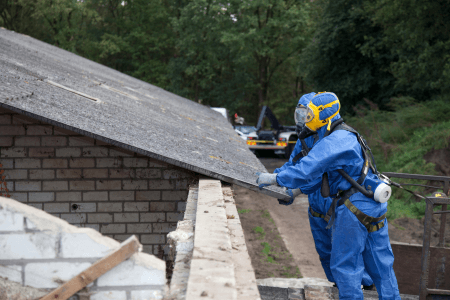Asbestos is a naturally occurring group of minerals with long, thin fibers. These fibers are remarkably strong and versatile, resistant to heat, fire, and chemicals, and they don’t conduct electricity. Because of these properties, asbestos was widely used in construction, automotive, and many other industries.
However, there’s a serious downside. When products containing asbestos are disturbed, the tiny fibers become airborne. If inhaled, these fibers can lodge in the lungs, where they remain for years. Over time, this accumulation can lead to severe health problems.
The Dangers of Asbestos Exposure
The danger lies in the microscopic nature of these fibers. When inhaled, they can lodge deep within the lungs, causing irritation and scarring over time. This can lead to a range of serious health problems, including:
- Asbestosis: A chronic lung disease that makes breathing difficult.
- Lung cancer: The most common cancer linked to asbestos exposure.
- Mesothelioma: A rare and aggressive cancer of the lining of the lungs, chest, or abdomen.
Where Might Asbestos Be Found in My Home?
Asbestos was widely used in building materials before the dangers were fully understood. Here are some common locations where you might find asbestos in older homes (built before the mid-1970s):
- Insulation: Pipe insulation, spray-on attic insulation, and loose-fill insulation (blown-in) are common culprits.
- Flooring: Vinyl floor tiles and backing, as well as linoleum adhesive, may contain asbestos.
- Ceilings: Textured popcorn ceilings were sometimes sprayed with asbestos-containing materials.
- Walls: Some wall texture coatings and plaster may contain asbestos.
- Other Materials: Roofing shingles, siding materials, and even some patching compounds could contain asbestos.
Who’s Most at Risk for Asbestos-related Diseases?
While everyone encounters trace amounts of asbestos in the environment, the risk of developing a related illness hinges on the level and duration of exposure. Here’s a breakdown of the groups most susceptible:
High-Risk Occupations
- Construction and Trades Workers: These individuals, particularly those involved in pre-1970s construction, may have encountered asbestos in insulation, flooring materials, and ceiling textures. Demolition, drywall removal, and asbestos abatement specifically involve direct interaction with the hazardous material.
- Shipyard Workers: Shipbuilding historically relied heavily on asbestos for its fire-resistant properties, putting workers at significant risk.
- Mining and Manufacturing: Individuals involved in extracting, processing, and creating asbestos products faced prolonged exposure.
- Firefighters and Auto Mechanics: While the risk in these professions is lower compared to the above, exposure to asbestos-containing materials can still occur.
Family Members of Asbestos-Exposed Workers
Though less common, family members of workers heavily exposed to asbestos can be at risk. Fibers can be brought home on clothes and contaminate living spaces, leading to secondary exposure.
Individuals Living Near Asbestos Mines
Studies have shown a higher risk of mesothelioma, a rare cancer linked to asbestos, in people residing near asbestos mines. This suggests that prolonged environmental exposure can be a factor.
Understanding Your Risk
The severity of health risks associated with asbestos exposure depends on several factors:
- Exposure Dose: The amount of asbestos inhaled significantly impacts the risk.
- Exposure Duration: Longer exposure periods lead to a higher chance of developing health problems.
- Fiber Characteristics: The fibers’ size, shape, and chemical composition influence their potential harm.
- Smoking: Smoking significantly increases the risk of asbestos-related lung cancer.
- Pre-existing Lung Conditions: Individuals with pre-existing lung issues are more vulnerable to the damaging effects of asbestos.
- Genetics: Some genetic factors may influence susceptibility to asbestos-related diseases.
How Can I Tell if My Home Contains Asbestos?
Unfortunately, you can’t tell for sure just by looking. The only way to be certain is to have suspected materials tested by a qualified professional. Here are some tips:
- Identify suspect materials based on the information above.
- Look for signs of damage or wear on these materials. Disturbed asbestos is more likely to release fibers.
- Hire a licensed asbestos inspector to collect samples and have them analyzed in a laboratory.
What Should I Do if I Find Asbestos in My Home?
Don’t panic! Intact asbestos that is not disturbed typically poses minimal risk. The key is to avoid disturbing it. Here’s what to do:
- Leave the material undisturbed. Don’t attempt to remove or repair asbestos yourself.
- Contact a qualified asbestos abatement contractor for professional assessment and recommendations. They can encapsulate the material to prevent further release of fibers or safely remove it if necessary.
- Maintain good air quality. Regularly clean your home with a damp cloth to trap dust particles. Consider upgrading your air filter to one with a high Minimum Efficiency Reporting Value (MERV) rating.
Living with Asbestos Safely
If you have asbestos in your home that is encapsulated or otherwise managed by a professional, you can likely continue living there safely. Here are some ongoing precautions:
- Minimize disturbance: Avoid activities that could damage or release asbestos fibers, such as drilling or sanding near asbestos-containing materials.
- Maintain good ventilation: Open windows and doors regularly to improve airflow and remove potential dust particles.
- Monitor the condition of asbestos-containing materials: Regularly inspect for signs of damage and schedule re-inspections with a qualified professional if necessary.
Remember: Knowledge is power. By understanding the risks and taking appropriate action, you can protect yourself and your family from the dangers of asbestos exposure.
Schedule Asbestos Testing & Removal
We have a team of certified specialists in the areas of testing, abatement and remedial services. Get a free quote for asbestos removal in your space.
Additional Resources:
- The Government of Canada website provides more information on asbestos toxins: https://www.canada.ca/en/environment-climate-change/services/management-toxic-substances/list-canadian-environmental-protection-act/asbestos.html
- The Canadian Centre for Occupational Health and Safety offers resources for homeowners and professionals: https://www.ccohs.ca/

